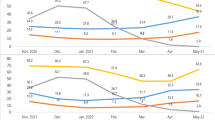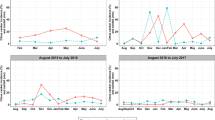Abstract
To control downy mildew of sweet basil (Ocimum basilicum L.), incited by Peronospora belbahrii Thines, a number of compounds were tested in 2011 and 2012 under glasshouse conditions. These included copper-based fungicides, biocontrol agents, and compounds previously reported to induce resistance in plants to pathogens. Results were compared with those provided by fungicides registered for downy mildew control in Italy. The tested compounds were used alone or applied in rotation in spray programs. In all trials, the greatest reduction in disease incidence and severity was found with treatments that included metalaxyl-M + copper hydroxide, a mineral fertilizer ‘Alexin’, mandipropanid, and azoxystrobin. The glucohumates activator complex and acibenzolar-S-methyl also provided significant disease control (P < 0.05). The mineral fertilizer Alexin, the glucohumates activator complex and acibenzolar-S significantly reduced disease incidence and severity 20 days after the last treatment compared with the untreated control (P < 0.05). Among the copper-based products, the greatest reductions in disease incidence and severity were provided by copper hydroxide with terpenic alcohols and copper oxychloride + copper hydroxide. The mineral fertilizer Kendal and prohexadione-Ca, as well as mustard oil, partially reduced disease incidence and severity compared with the untreated control (P < 0.05), whereas the biocontrol agent Bacillus subtilis QST 713 and thyme oil extract were not effective in two out of three trials. When different combinations of various products used in rotation were tested, effective control was found either using a rotation of fungicides with compounds that can induce resistance, as well as by using rotation with different resistance-inducing compounds on their own.
Similar content being viewed by others
References
Bazzi, C. C., Messina, L., Tortoreto, E., Stefani, F., Bini, A., Brunelli, C., et al. (2003). Control of pathogen incidence in pome fruits and other horticultural crop plants with prohexadione-Ca. European Journal of Horticultural Science, 68, 108–114.
Belbahri, I., Calmin, G., Pawlowski, J., & Lefort, F. (2005). Phylogenetic analysis and real time PCR detection of a presumably undescribed Peronospora species on sweet basil and sage. Mycological Research, 109, 1276–1287.
Bock, C. H., Brenneman, T. B., Hotchkiss, M. W., & Wood, B. W. (2012). Evaluation of a phosphite fungicide to control pecan scab in the southeastern USA. Crop Protection, 36, 58–64.
Brent, K. J., & Hollomon, D. W. (2007). Fungicide resistance in crop pathogens: How can it be managed? FRAC Monograph No. 1 (2nd, revised ed.). Brussels: Croplife International.
Cohen, Y., Rubin, A., & Gotlieb, D. (2008). Activity of carboxylic acid amide (CAA) fungicides against Bremia lactucae. European Journal of Plant Pathology, 122, 169–183.
Coosemans, J. (2004). First report of Peronospora lamii, downy mildew on basil (Ocimum basilicum) in Belgium. Parasitica, 60, 27.
Csizinsky, A. A. (1993). The potential for aromatic plant production with plastic mulch culture in Florida. Acta Horticulturae, 331, 27–34.
EPPO (2004). EPPO Standards PP1 (2nd ed., Vol. 2, pp. 94–97). Paris, France: European and Mediterranean Plant Protection Organization.
Garibaldi, A., Bertetti, D., & Gullino, M. L. (2007). Effect of leaf wetness duration and temperature on infection of downy mildew (Peronospora sp.) of basil. Journal of Plant Diseases and Protection, 114, 6–8.
Garibaldi, A., Gilardi, G., Bertoldo, C., & Gullino, M. L. (2011). First report of leaf spot of sweet basil (Ocimum basilicum) caused by Alternaria alternata in Italy. Journal of Plant Pathology, 93, S4.71.
Garibaldi, A., Gullino, M. L., & Minuto, G. (1997). Diseases of basil and their management. Plant Disease, 81, 124–132.
Garibaldi, A., Minuto, G., Bertetti, D., & Gullino, M. L. (2004a). Seed transmission of Peronospora of basil. Journal of Plant Diseases and Protection, 111, 465–469.
Garibaldi, A., Minuto, A., & Gullino, M. L. (2005). First report of downy mildew of basil (Ocimum basilicum) in France. Plant Disease, 89, 683.
Garibaldi, A., Minuto, A., Minuto, G., & Gullino, M. L. (2004b). First report of downy mildew of basil (Ocimum basilicum) in Italy. Plant Disease, 88, 312.
Gisi, U., & Sierotzki, H. (2008). Fungicide modes of action and resistance in downy mildews. European Journal of Plant Pathology, 122, 157–167.
Guest, D. I., & Grant, B. R. (1991). The complex action of phosphonates as antifungal agents. Biological Reviews, 66, 159–187.
Gullino, M. L., Gilardi, G., & Garibaldi, A. (2009). Chemical control of downy mildew on lettuce and basil under greenhouse conditions. Communications in Agricultural and Applied Biological Sciences, 74, 933–940.
Hansford, C. G. (1932). Annual report of the mycologist. Review of Applied Mycology, 12, 421.
Ishii, H., Tomita, Y., Horio, T., Naruska, Y., & Nakazawa, Y. (1999). Induced resistance of acibenzolar-S-methyl (CGA245704) to cucumber and Japanese pear diseases. European Journal of Plant Pathology, 105, 77–85.
ISTAT (2011). http://www.istat.it/en/products/databases.
Jackson, T. J., Burgess, T., Colquhoun, I., Hardy, G.E. St. J. (2000). Action of fungicide phosphite on Eucalyptus marginata inoculated with Phytophthora cinnamomi. Plant Pathology, 49, 147–154.
Ji, P., Yin, J., & Koné, D. (2011). Application of acibenzolar-S-methyl and standard fungicides for control of Phytophthora blight on squash. Crop Protection, 30, 1601–1605.
Kappert, R., Djufri, I., & Balas, J. (2011). Testing a plant strengthening agent in horticulture. Bulletin UASVM Horticulture, 68, 375–379.
Kofoet, A., & Fischer, K. (2007). Evaluation of plant resistance improvers to control Peronospora destructor, P. parasitica, Bremia lactucae and Pseudoperonospora cubensis. Journal of Plant Diseases and Protection, 114, 54–61.
LaMondia, J. A. (2008). Actigard increases fungicide efficacy against tobacco blue mold. Plant Disease, 92, 1463–1467.
LaMondia, J. A. (2009). Efficacy of fungicides and a systemic acquired resistance activator (acibenzolar-S-methyl) against tobacco blue mould. Crop Protection, 28, 72–76.
Leadbeater, A., & Gisi, U. (2010). The challenges of chemical control of plant diseases. In U. Gisi, I. Chet, & M. L. Gullino (Eds.), Recent developments in management of plant diseases (pp. 3–17). Dordrecht: Springer.
Lefort, F., Gigon, V., & Amos, B. (2003). Le mildiou s’étend. Dejà dètecté dans des nombreux pays européens, Peronospora lamii, responsible du mildiou de basilic, a été observé en Suisse dans la région lémanique. Réussir Fruits et Légumes, 223, 66.
Lucier, G. (1993). Vegetables and specialties situation and outlook report. Commodities Economic Research Service, U.S. Dep. Agric., Nov: TVS-261.
Malolepsza, U. (2006). Induction of disease resistance by acibenzolar-S-methyl and o-hydroxyethylorutin against Botrytis cinerea in tomato plants. Crop Protection, 25, 956–962.
Martinelli, J. A., Brown, J. K. M., & Wolfe, M. S. (1993). Effects of barley genotype on induced resistance to powdery mildew. Plant Pathology, 42, 195–202.
Martinez de la Parte, E., Pérez-Vicente, L., Bernal, B., & Garcia, D. (2010). First report of Peronospora sp. on sweet basil (Ocimum basilicum) in Cuba. Plant Pathology, 59, 800.
Mersha, A., Zhang, S., & Raid, R. N. (2012). Evaluation of systemic acquired resistance inducers for control of downy mildew on basil. Crop Protection, 40, 83–90.
Minuto, G., Minuto, A., Gullino, M. L., & Garibaldi, A. (2004). Lotta chimica alla peronospora del basilico: primi risultati. Informatore Fitopatologico – La Difesa delle Piante, 54(4), 54–57.
Molina, A., Hunta, M. D., & Ryalsa, J. A. (1998). Impaired fungicide activity in plants blocked in disease resistance signal transduction. The Plant Cell, 10, 1903–1914.
Montalti, M. (1995). Producendo basilico in coltura protetta. Colture Protette, 24, 45–49.
Nagy, G., & Horvath, A. (2011). Occurrence of downy mildew caused by Peronospora belbahrii on sweet basil in Hungary. Plant Disease, 95, 1034.
Oostendorp, M., Kunz, W., Dietrich, B., & Staub, T. (2001). Induced disease resistance in plants by chemicals. European Journal of Plant Pathology, 107, 19–28.
Perez, L., Rodriguez, M. E., Rodriguez, F., & Roson, C. (2003). Efficacy of acibenzolar-S-methyl, an inducer of systemic acquired resistance against tobacco blue mould caused by Peronospora hyoscyami f.sp. tabacina. Crop Protection, 22, 405–413.
Roberts, P. D., Raid, R. N., Harmon, P. F., Jordan, S. A., & Palmateeer, A. J. (2009). First report of downy mildew caused by a Peronospora sp. on basil in Florida and the United States. Plant Disease, 93, 199.
Silva, O. C., Santos, H. A. A., Dalla Pria, M., & May-De Mio, L. L. (2011). Potassium phosphite for control of downy mildew of soybean. Crop Protection, 30, 598–604.
Skylakakis, G. (1981). Effects of alternating and mixing pesticides on the build up of fungal resistance. Phytopathology, 71, 1119–1121.
Smille, R., Grant, B. R., & Guest, D. (1989). The mode of action of phosphite: evidence for both direct and indirect modes of action on three Phytophthora spp. in plants. Phytopathology, 79, 921–926.
Spencer, D. M. (1981). The downy mildews. London, UK: Academic.
Thines, M., Telle, S., Ploch, S., & Runge, F. (2009). Identity of the downy mildew pathogens of basil, coleus, and sage with implications for quarantine measures. Mycological Research, 113, 532–540.
Vallad, G. E., & Goodman, R. M. (2004). Systemic acquired resistance and induced systemic resistance in conventional agriculture. Crop Science, 44, 1920–1934.
Van Loon, L. C., Bakker, P., & Pieterese, C. M. J. (1998). Systemic resistance induced by rhizosphere bacteria. Annual Review of Phytopathology, 36, 453–483.
Walters, D. R., & Fountaine, J. M. (2009). Practical application of induced resistance to plant disease: an appraisal of effectiveness under field conditions. Journal of Agricultural Science, 147, 523–535.
Wicks, T. J., Magarey, P. A., Wachtel, M. F., & Frensham, A. B. (1991). Effect of post infection application of phosphonic acid on Plasmopara citricola on grapevine. Plant Disease, 75, 40–43.
Wyenandt, C. A., Simon, J. A., McGrath, M. T., & Ward, D. L. (2010). Susceptibility of basil cultivars and breeding lines to downy mildew (Peronospora belbahrii). HortScience, 45, 1416–1419.
Ziadi, S., Barbedette, S., Godard, J. F., Monot, C., Le Corre, D., & Silué, D. (2001). Production of pathogenesis-related proteins in the cauliflower (Brassica oleracea var. Botrytis) – downy mildew (Peronospora parasitica) pathosystem treated with acibenzolar-S-methyl. Plant Pathology, 50, 579–586.
Acknowledgments
Work carried out in the framework of the project SAFEFOODCONTROL, funded by Regione Piemonte “Sviluppo di sistemi e tecnologie innovative per la produzione, conservazione, trasformazione e valorizzazione dell’orto-frutticoltura piemontese di qualità”. The authors thank Dr. Piter Mazzoglio for language revision.
Author information
Authors and Affiliations
Corresponding author
Rights and permissions
About this article
Cite this article
Gilardi, G., Demarchi, S., Garibaldi, A. et al. Management of downy mildew of sweet basil (Ocimum basilicum) caused by Peronospora belbahrii by means of resistance inducers, fungicides, biocontrol agents and natural products. Phytoparasitica 41, 59–72 (2013). https://doi.org/10.1007/s12600-012-0264-y
Received:
Accepted:
Published:
Issue Date:
DOI: https://doi.org/10.1007/s12600-012-0264-y




